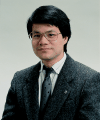 / Shunji Mori / Professor
/ Shunji Mori / Professor
 / Tony Y. T. Chan / Assistant Professor
/ Tony Y. T. Chan / Assistant Professor
 / Yu Nakajima / Research Associate
/ Yu Nakajima / Research Associate



 / Shunji Mori / Professor
/ Shunji Mori / Professor
 / Tony Y. T. Chan / Assistant Professor
/ Tony Y. T. Chan / Assistant Professor
 / Yu Nakajima / Research Associate
/ Yu Nakajima / Research Associate
First and foremost, the Image Processing Laboratory engages in research and development of image pattern recognition systems. More specifically, as can be seen from the background information and the recent research publications of the members of the laboratory, character recognition is our current focus. Related to the recent involvement of multimedia systems, character recognition has been noted by many researchers and engineers. On the other hand, character recognition techniques are generally divided into off-line and on-line methods. The former is typical in character recognition and aims at duplicating the human ability in recognition. However, on-line character recognition is also noted recently in connection with so-called pen computers. On-line methods provide very flexible, convenient, and natural human-interface. Historically speaking, these techniques have been developed separately. However, both techniques can be developed together in principle. The common approach makes possible recognition flexibility in such a way that the usual constraints being imposed on the on-line techniques can be removed. For example, writing order and number of stokes constituting a character are typical of such constraints. On the other hand, we are developing some automated visual inspection systems for flow of Sake bottles, piston rings, and mirrors of industry use, according to a domestic company. The contribution to the domestic industry is very important mission of our University. In general, image inspection is a very important theme and has many applications in industry broadly. Prof.Mori and Mr.Nakajima have engineering background. Actually, Prof.Mori was a leader of an OCR group when he worked for Ricoh Research and Development Center and developed a very powerful OCR package which is used in practice. One of the members of the OCR group was Mr. Nakajima, who has joined us as a research associate. He is well-acquainted with different computer systems and also works as an instructor in programming. The system developed is called filtering in character recognition, which makes the packages very fast without being hardware-specific. The OCR group were awarded the Excellence in Programming Prize from the Ministry of Post and Telecommunications. The basic configuration of the system was proposed by Prof. Mori.
Naturally, the essential point of the developed system lies in the excellent algorithm of character recognition, which is based on an algebraic approach at shape description. This approach was investigated as basic research by Prof. Mori when he worked for the Electro-technical Laboratory of the Ministry of International Trade and Industry. Later the basic line was further developed, in theory and in practice, by Dr. Nishida who was an associate professor in our laboratory. We think that is one of the most elegant theories in character recognition. Because of its theoretical richness and high-level abstraction, the very broad applications in shape recognition in general. It is applicable to both off-line and on-line character recognition systems, for example. Further extension of the theory is in the application of the recognition of three-dimensional bodies, in which a piece of the surfaces must be represented effectively in terms of pattern recognitions and global organization mechanism. In this regard, a set of primitive surfaces must be considered. Furthermore, in addition to basic recognition mechanisms in a bottom-up manner. rich knowledge concerning ``objects" must be naturally employed. Some knowledge representational methods developed in the field of artificial intelligence research are being considered. Assistant Professor Chan is investigating unifying pattern recognition and artificial intelligence approaches.
Refereed Journal Papers
Refereed Proceeding Papers


